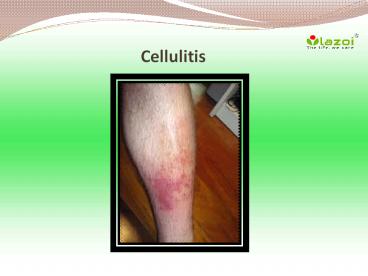Cellulitis: Symptoms, Causes, Diagnosis, Treatment, Prevention and Complications - PowerPoint PPT Presentation
Title:
Cellulitis: Symptoms, Causes, Diagnosis, Treatment, Prevention and Complications
Description:
Cellulitis is a non-contagious bacterial skin infection that affects the deeper layer of the skin along with subcutaneous tissues under the skin. – PowerPoint PPT presentation
Number of Views:287
Title: Cellulitis: Symptoms, Causes, Diagnosis, Treatment, Prevention and Complications
1
Cellulitis
2
Cellulitis
- Cellulitis is a non-contagious bacterial skin
infection that affects the deeper layer of the
skin along with subcutaneous tissues under the
skin. Bacteria present on the skin generally do
not cause any harm. However, they can enter the
deeper layer of skin through a cut or wound and
cause infection. Cellulitis infection can occur
anywhere in the body, but usually affects the
lower legs. Cellulitis can be fatal if the
bacterium enters the bloodstream or lymph nodes.
This skin infection can affect people of all
ages. Cellulitis results in the swelling,
tenderness, and redness around the affected
area.
3
Causes of cellulitis
- The bacteria staphylococcus and streptococcus is
responsible for the occurrence of cellulitis.
These bacteria enter the skin through a wound,
which may be caused to an injury, insect bite, or
surgical incision. Sometimes, a break in the skin
can also occur due to burns, grazes, ulcers, or
other skin conditions such as eczema or psoriasis.
4
Risk factors for cellulitis
- The risk of developing a cellulitis increase in
people who have - Diabetes
- Poor blood circulation
- HIV/AIDS
- Skin infection
- Weak immune system
- Cracks in the skin
5
Symptoms
- Common symptoms of cellulitis are
- Shaking
- Chills
- Fatigue
- Fever
- Blister filled with pus
- Inflammation in the skin
- Excessive sweating
- Muscle aches
- Dizziness
- Lightheadedness
- Swollen lymph nodes
6
Diagnosis of cellulitis
- A dermatologist will start the diagnosis of
cellulitis by performing a physical exam and
asking about your medical history. After this, he
may take a sample of the affected tissue to
observe it under the microscope. This will help
him to identify the type of bacteria causing
cellulitis. A blood test can also determine the
presence of bacteria in the body.
7
Treatment
- The main objective behind the treatment of
cellulitis is to stop the bacteria from reaching
the bloodstream. A dermatologist will start
the treatment of cellulitis by prescribing
antibiotics. These antibiotics are effective in
reducing the symptoms of cellulitis such as
reddening of skin and inflammation. A patient may
receive antibiotics orally or intravenously.
Drink plenty of water to maintain the normal flow
of blood in the body. A patient diagnosed with
cellulitis should keep the affected area elevated
in order to reduce swelling.
8
Complications of cellulitis
- If Cellulitis is left untreated, it may result
in serious complications such as - Spread of infection to other body parts
- Blood infection and sepsis
- Irregular heartbeat
- Low blood pressure
- Persistent swelling
9
Prevention of cellulitis
- Use moisturizer to prevent the skin from getting
dry - Use antibacterial soap for cleaning the wounds
- Keep the cuts clean, covered, and dry
- Maintain weight
- Avoid scratching of skin
10
CONNECT WITH US
- Logon to
- www.lazoi.com
- Like us on Facebook
- https//www.facebook.com/LazoiTheLife
- Follow us on Twitter
- https//www.twitter.com/lazoithelife
- Follow us on Pinterest
- https//www.in.pinterest.com/lazoithelife






























